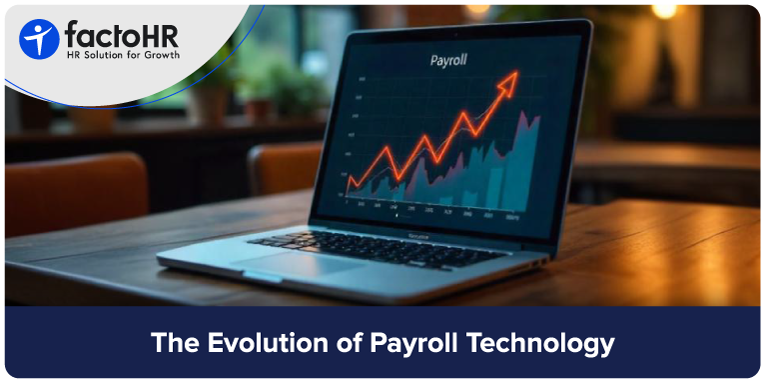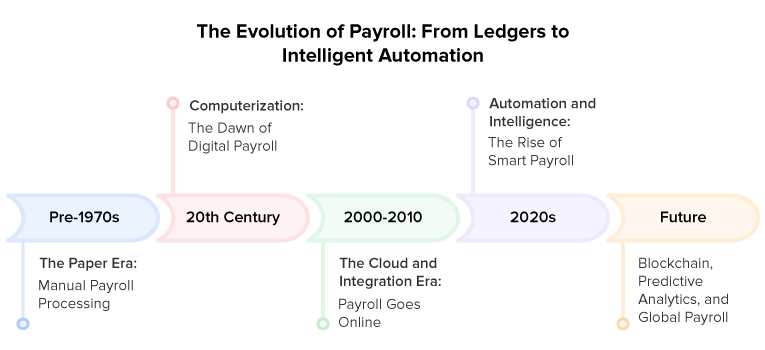Evolution of Payroll Technology

Table of Contents
Traditional payroll processing includes relying on spreadsheets or maintaining manual records in a ledger that often breaks down at critical points, generally on payday.
The payroll process has significantly evolved over the years. With the integration of new technologies, many modern systems operate smoothly and accurately with minimal human intervention.
The transformation in payroll technology has replaced tedious manual calculations with smart, automated solutions. This transformation allows the HR and payroll team to dedicate more time to strategic initiatives rather than identifying and correcting formula errors in spreadsheets.
Technological advancements in the payroll process have significantly reduced inaccuracies, saved time, increased efficiency, and improved overall organizational operations.
This blog will examine the evolution of payroll technology, from manual payroll processes to the advanced automated systems currently in use.

The Evolution of Payroll: From Ledgers to Intelligent Automation
Payroll has evolved from manual bookkeeping with spreadsheets and registers to intelligent automation powered by cloud, AI, and real-time compliance. Let us explore the phases of payroll technology.

The Paper Era: Manual Payroll Processing
Before the 1970s, businesses practiced manual payroll processing. They used to hire people with specialized training for payroll processing. All payroll functions, like data collection, salary calculation, checking leave balance, performance reviews, reimbursements, arrears, and bonuses, were handled manually. The main challenges experienced while manually processing payroll are:
- Error-Prone: Depending on manual processing of core payroll tasks, such as tracking attendance, leave, and working hours, can increase the risk of data entry errors, miscalculations, and the use of outdated information. Furthermore, managing updates to tax laws and regulations can present difficulties, thereby escalating the possibility of errors that could impact the financial stability of an organization.
- Time-consuming: Processing payroll manually is a complicated and very time-intensive task.
- Scalability: The scope of manual processes is limited because, as the organization grows, the difficulty in managing payroll increases, and the workforce required to perform payroll tasks will increase. Hence increasing the cost of operations.
- Compliance: In India, the government revises tax slabs annually. Therefore, it is difficult to be consistent with the new tax laws every year.
Therefore, manual payroll processing cannot ensure consistency.
Computerization: the Dawn of Digital Payroll
Computerization reengineered manual payroll processes into software applications in the 20th century. The advancement in technology helped reduce payroll errors and increase the speed of HR operations, all while maintaining quality.
Initially, payroll process tasks would take a few days to complete, but computers could now complete them in hours or minutes. Computers laid the foundation of smart payroll. However, computerization came with new challenges. Here are the significant challenges faced by the companies.
- Adaptability: The employees were resistant to change to new ways of operating. The latest techniques were unfamiliar, and employees felt hesitant about adapting to the technology.
- High Costs: In those days, not every company could afford computers due to their high costs and the need for ongoing maintenance.
- Software limitations: Early payroll technology was not flexible enough to handle complex functions, such as multiple tax jurisdictions and variable payment schedules.
- Data Migration: One of the major problems is transferring the old paper data into the new computer system. In this process, there is a high chance of data loss.
- Regulatory Compliance: Taxes and laws are constantly changing, and keeping the software up to date has been a significant challenge.
The Cloud and Integration Era: Payroll Goes Online
The shift to cloud computing happened between 2000 and 2010. Cloud-based payroll solves the issue of scalability. Previously, the data was stored on-premise, and then cloud computing helped store data online. Cloud storage can handle a massive amount of data, making it easy to manage new data as the organization expands.
The need for physical hardware decreases, and therefore, IT expense decreases. However, several challenges are associated with cloud computing.
- Data Security: It is one of the significant challenges as the data is stored online. The company does not have complete control over the data. The power remains with the cloud payroll software provider. Therefore, there is a chance of a data breach.
- Cost Management: Companies that outsource payroll automation software from a vendor must be aware of the hidden costs involved.
- Performance Challenge: Cloud computing requires sufficient bandwidth and tools to operate smoothly. Failing to utilize these resources would result in poor performance.

Automation and Intelligence: the Rise of Smart Payroll
Smart payroll emerged in the 2020s, driven by the growth of artificial intelligence, revolutionizing payroll by automating core operations such as calculating wages, taxes, deductions, and benefits.
This advanced technology provides real-time updates that simplify compliance management, improving accuracy and speed. This results in notable improvements in operational efficiency and creates a better employee experience through smart payroll.
Implementing an automated payroll system reduces the need for manual tasks. The payroll app minimizes mistakes and ensures that payroll standards are maintained. The payroll integration with AI enables real-time data, helping the HR team work more efficiently. AI easily adapts to new laws and regulations, allowing the company to foray into another country.
Payroll automation reduces operational costs and saves time. This helps the HR department to focus on the long-term plans and enhance the organization’s productivity.
Employee-Centric Innovations: Mobility and Self-Service
Employee-centric innovations feature an ESS (employee self-service) portal and mobile apps. The ESS portal provides a user-friendly interface that allows employees to quickly and easily access their personal information.
ESS saves time, streamlines documentation, and increases organizational productivity. Moreover, employees can review and update the data as required. With business expansion, implementing digital change becomes crucial.
Looking Ahead: Blockchain, Predictive Analytics, and Global Payroll
The future of payroll is moving towards blockchain and predictive analytics. Blockchain is a decentralized digital ledger that facilitates solid security and transparency. Integrating blockchain with payroll enhances payment gateways and ensures that every payment is traceable. It protects the data against any unauthorized changes and interference. All the transactions are encrypted and tamper-proof.
Predictive Analytics uses data to understand the patterns and helps to forecast future trends. It operates by analyzing past and present data through machine learning and generates output for HR professionals. The outputs of predictive analytics enable HR professionals to make data-driven decisions.
Forecasting of employee retention rates, employee turnover rates, employee satisfaction, and employee performance. These metrics are important for the HR department, and predictive analytics makes it easy to access through the payroll app.

Conclusion
There is no limit to the evolution of payroll technology. The future of payroll will adapt to the changing environment of businesses. Payroll automation will have a positive impact on the bottom line. Regardless of the organization’s size, a smart payroll system will assist with all payroll activities.
Blockchain will solidify the payroll system, and predictive analytics will assist in forecasting future employee trends and behaviour. The future of payroll will focus on improving the employee experience.
Grow your business with factoHR today
Focus on the significant decision-making tasks, transfer all your common repetitive HR tasks to factoHR and see the things falling into their place.

© 2026 Copyright factoHR


